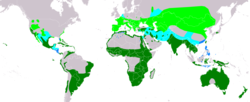| Black-winged stilt | |
|---|---|
 | |
 | |
| Black-winged stilt in Marievale Nature Reserve | |
| Scientific classification | |
| Kingdom: | Animalia |
| Phylum: | Chordata |
| Class: | Aves |
| Order: | Charadriiformes |
| Family: | Recurvirostridae |
| Genus: | Himantopus |
| Species: | H. himantopus |
| Binomial name | |
| Himantopus himantopus | |
 | |
| Range of H. himantopus ( sensu lato , see text) Breeding Resident Passage Non-breeding | |
| Synonyms | |
| |
The black-winged stilt (Himantopus himantopus) is a widely distributed, very long-legged wader in the avocet and stilt family Recurvirostridae. Its scientific name, Himantopus himantopus, is sometimes used to generalize a single, almost cosmopolitan species. Alternatively, it is restricted to the form that is widespread in Europe, Asia and Africa, which equals the nominate group of H. himantopus sensu lato . Meanwhile, the black-necked (H. mexicanus) and white-backed stilts (H. melanurus) both inhabit the Americas; the pied stilt (H. leucocephalus) ranges from Australia and New Zealand. Today, most sources accept between one and four actual species. [1] [2] [3] [4]








